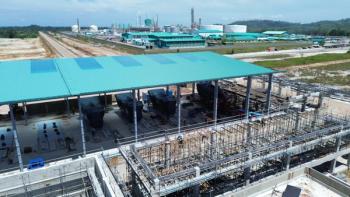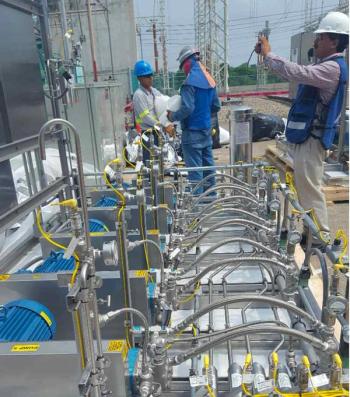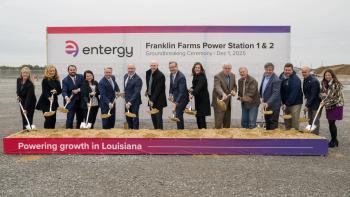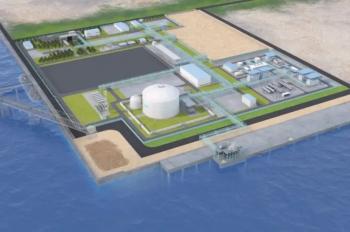
INDUSTRY NEWS
Voith/BHS technology day
Late last year, Voith/BHS held a technology day in Sonthofen, Germany. Some 95 turbomachinery experts were present, representing OEMs, engineering companies and end users from industries such as oil & gas, petrochemicals, industrial gases and power. An initial presentation focused upon the company’s gearing capabilities.
Wolfgang, Sautter, Managing Director of Voith Gears, talked about the steady advances in power, speed and pitch line velocity over many decades (See chart).
“The future will be about combinations of higher power, speed and efficiency, while lowering oil consumption and noise,” said Sautter.
He called attention to an integral gear that Voith provided for a mega project used for purified terephthalic acid (PTA is used in the production of plastic bottles and clothing) in China. This 4,600 mm shaft offset model transmits around 50,000 kW. Known as the WGC5-460TZ, its five compressor pinions are driven by a steam turbine and an electrical motor supplied to MAN Turbo AG. According to Sautter, it currently is the largest gear unit ever built.
Using a ballpark figure for technical feasibility, Sautter said, the following levels can be achieved:
• Parallel Shaft Gears: 140 MW or 30,000 rpm
• Integral Gears: 50 MW or 60,000 rpm
• Epicyclic Gears: 40 MW or 80,000 rpm
“Even a few years ago, one also couldn’t imagine that the 50 MW limit for integral gears would be passed,” said Sautter. “The demands upon gearbox manufacturers from OEMs will continue to rise, but it is hard to predict where it will be in 5 or 10 years.”
In addition, Sautter covered Voith’s power distribution gearbox which operates on the power-split principle to lower stress levels while operating at higher power/speed. The company views this as a possible solution to future demands, but also to some current applications for parallel shaft and epicyclic gear units which are reaching their technical limits.
“A likely application for power distribution gears is gas turbine driven centrifugal compressors where both high power and high speeds have to be transmitted,” said Sautter.
Andreas Saenger, Area Manager, Gears and Components at Voith BHS, presented on bearing design development and compared BHS Ultra Cool Bearing to tilting pad bearings. Modifications to the BHS Lemon Offset Bearing (additional cooling holes, copper chrome backing material, and special oil pockets) led to the Ultra Cool Bearing.
Saenger compared the geometries between tilting pad bearing and the new BHS offering. BHS claims that tests and operational experience prove a lower temperature, a lower oil flow and higher efficiency at given loads and journal velocities with its bearing design compared to other manufacturers
This shows the behavior of the BHS ultra cool bearing in lower oil temperatures even at the very high end of loads, demonstrating its suitability for demanding applications.
“The benefits are less power loss, higher efficiency, lower temperatures, reduction of oil changes, lower oil consumption and reduction of total cost of ownership,” said Saenger. “In addition, BHS Cool Bearings supply higher relative bearing/system damping for synchronous and non-synchronous vibrations.”
France to get a FlexEfficiency 50 plant
Electricite de France (EDF and GE announced plans to jointly develop the first FlexEfficiency 50 plant to be connected to a national grid. The combined-cycle plant will be located at Bouchain, an existing EDF power plant site in northern France, and will produce 510 megawatts.
It is expected to achieve greater than 61% efficiency at base load, based on GE test data. The turbine will be built at a manufacturing facility in Belfort, France.
GE’s FlexEfficiency 50 plant includes: a 9FB turbine; 109D-14 steam turbine that runs on the waste heat produced by the gas turbine; a W28 Generator, a Mark Vle control system; and an HRSG. It will be able to transition from a dead stop to full load in 28 minutes. Part load efficiency better than 60% can be maintained down to 85% load.
With this announcement GE is attempting to differentiate itself from Siemens — first to announce 60% combined cycle efficiency at its demonstration plant in Irsching, Germany. GE is highlighting the number of orders it has for its FlexEfficiency technology, as well as its test capabilities. According to Paul Browning, president and CEO of GE Energy’s Thermal Products business, the company now has seven orders for FlexEfficiency units.
“Other 60%-plus announcements are site specific,” said Browning. This EDF plant is scheduled to be GE’s first operational FlexEfficiency example when it opens in 2015. Siemens, meanwhile, has one unit running at 60% plus efficiency and supplying power to the German grid in Bavaria, as does Mitsubishi in Japan. Clearly, this is destined to become one of the most competitive zones within the turbomachinery sector in the coming years.
GE to build first IGCC plant in South Korea
GE has been selected by Korea Western Power Co. for the first integrated gasification combined cycle (IGCC) power plant to be built in South Korea. The 300 MW facility includes a 7F Syngas Turbine, a D11 steam turbine, an HRSG and aMark* VIe integrated control system (ICS). GE also will provide 10 years of maintenance services for the facility.
Dresser-Rand acquires Synchrony . . .
Dresser-Rand has acquired Synchrony, Inc. The transaction closed in January 2012. Synchrony products included active magnetic bearings (AMB), high speed motors and generators, and power electronics for rotating machinery. Under the agreement, Dresser-Rand will acquire Synchrony for approximately $50 million net of cash acquired.
. . . and invests in center of excellence for rotor repairs
Dresser-Rand is expanding its Turbine Technology Services facility in Houston, TX, to include a center of excellence for F-class rotor repair. Dresser-Rand Turbine Technology Services currently has 88,000 square feet under roof.
The facility provides repairs on mature and F-Class frame industrial gas and steam turbines and includes in-house coating capability, automated 5-axis laser welding, a metallurgical laboratory, a high-capacity vacuum and conventional heat treating facility, and a machine and weld shop. The new F-class rotor shop will add an additional 24,000 square feet with a 75-ton crane and 50 feet under hook, adequate for F-class rotors up to Frame 9.
Rolls-Royce wins gas turbine order
Rolls-Royce has won an order for gas turbine and compression equipment for the Tapis oil and gas field, offshore Malaysia. The equipment will be utilized by ExxonMobil Exploration and Production Malaysia to expand and extend the production of the field. The order includes two Rolls-Royce RB211- GT61 gas turbines, each driving twin Rolls-Royce RCB and RBB multi-stage barrel gas compressors.
Each gas turbine compressor set will produce 27MW of power, enough to deliver up to 390 million standard cubic feet of natural gas per day. Rolls-Royce will begin to deliver equipment in the third quarter of 2012, supporting the operator in developing the long-term potential of the Tapis field.
Elliott taps Art Titus as COO
Art Titus, former Director of Sales & Marketing , Engineered Products, has been named Chief Operation Officer, succeeding Tony Casillo, who retired in December after 36 years with the Elliott Group. Titus plans to strengthen the partnership between the Elliott and parent company, Ebara Corp., and double the size of the Elliott business by 2015.
Toshihiko Miyashita succeeds Art Titus as VP of Engineered Products. Mr. Miyashita has worked for Ebara for 36 years in various positions supporting the Elliott brand.
MAN pens contract with Shell
Shell selected MAN Diesel & Turbo for provisioning of rotating equipment and services. One six-year Enterprise Framework Agreement (EFA) was signed for the supply of new compression equipment for Shell locations worldwide and another five-year framework agreement was signed for the supply of aftermarket parts and services for existing rotating equipment.
Ansaldo steam turbine order
Ansaldo Energia has been awarded a contract in Egypt worth about EUR 90 million. The order is for the supply and assembly of two 280 MW steam turbines, related generators and auxiliary systems for the combined-cycle power station in Giza North (on the outskirts of Cairo), managed by the Cairo Electricity Production Co., a company owned by the Egyptian Electricity Holding Co, the state power company.
Siemens lands SGT-750 order
Siemens Energy has received the first order for its SGT-750 industrial gas turbine (See p. 22). The purchaser is Kassel-based WINGAS GmbH, a joint venture of the BASF subsidiary Wintershall and the Russian company Gazprom, which operates a Germanywide natural gas pipeline network. The turbine, with a rating of 36 MW, will be deployed in the landfall station of the Nord Stream pipeline in Lubmin.
The Nord Stream pipeline, which in the future will link Europe with the large natural gas reserves in Siberia, will end at Lubmin near Greifswald in Germany. The SGT-750 turbine will be deployed in a cogeneration plant at the landfall station, where the electric power generated will be fed into the grid. The heat from the SGT-750 will reheat the pipeline gas and restore it to the temperature needed for further distribution, compensating for the Joule- Thomson effect which causes cooling of the gas during a pressure drop.
U.S. base for manufacturer
KST-Turbine Components, GmbH, a service parts manufacturer based out of Berlin, Germany, has opened an office in Charlotte, NC to provide services directly to North American customers. KST is specialized in manufacturing all major gas and steam turbine components such as segment/labyrinth seals, burning chamber components (nickel alloy), valve assemblies, couplings, special connectors, shafts and bearings in singlepiece production.
MHI ships M501J turbine
Mitsubishi Heavy Industries (MHI) has shipped the first commercial-use unit of the M501J from its Takasago Machinery Works in Takasago, Hyogo, to the Himeji No.2 Power Station of Kansai Electric Power Co., Inc. The M501J has achieved an inlet temperature of 1,600ºC.
Six units are slated to go on-stream progressively between October 2013 and October 2015.
Capstone’s Nigerian deal
Capstone Turbine Corporation has received an order for C1000 and C200 microturbines for use at a large Nigerian pharmaceutical company. Capstone distribution partner, Makon Power Systems LTD, will supervise the installation and provide commissioning and ongoing aftermarket support for the system.
“This order represents Makon Power Systems’ second multiple-unit order and first purchase of Capstone's C200 and C1000 products,” says Ademola Ajakaye, Makon's Chief Operating Officer. “The microturbines will be used to provide power and thermal energy for the manufacturing process, improving the efficiency of the plant and its carbon footprint.”
Newsletter
Power your knowledge with the latest in turbine technology, engineering advances, and energy solutions—subscribe to Turbomachinery International today.





